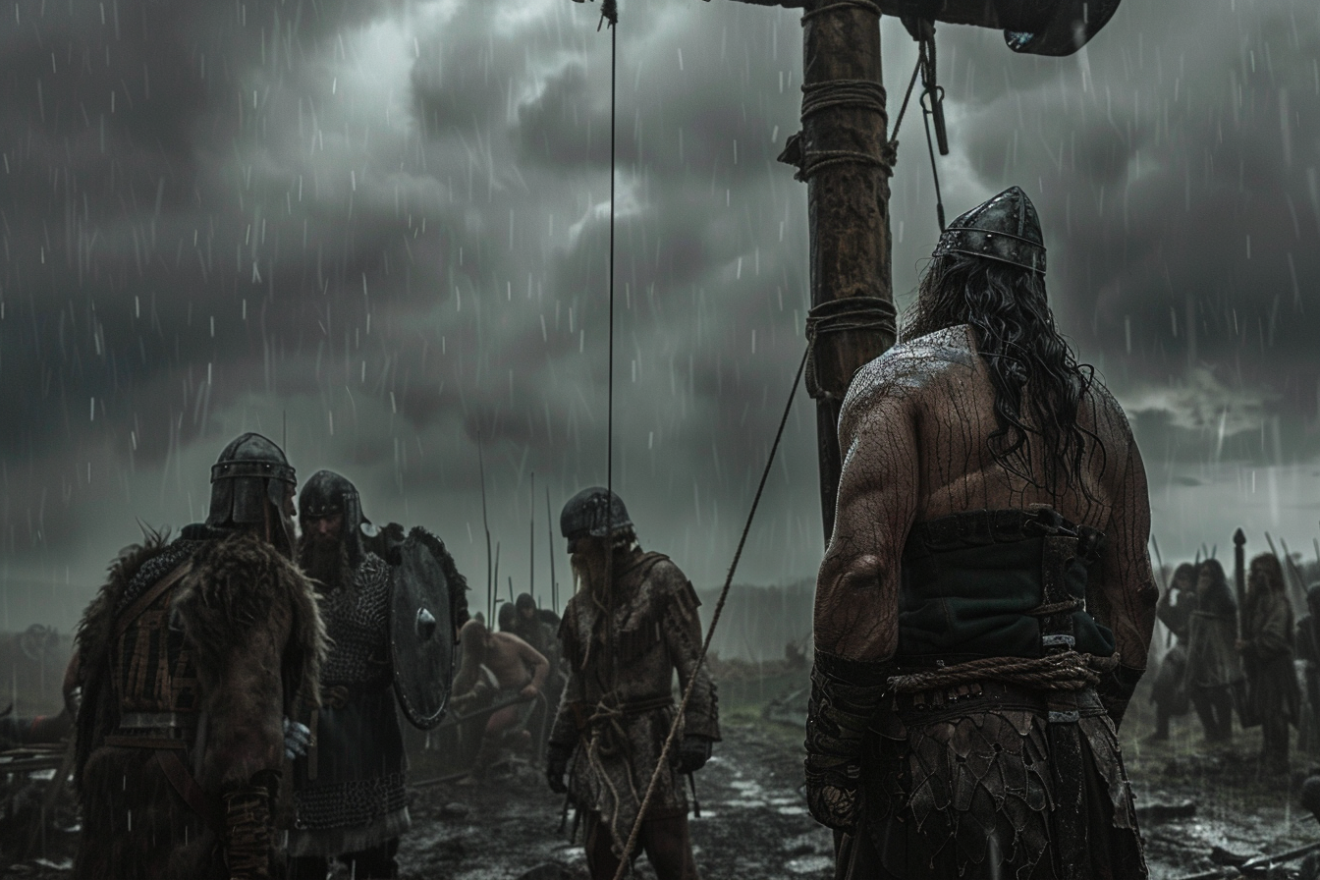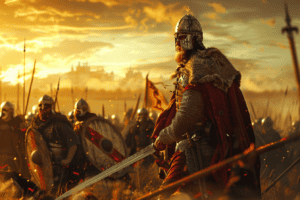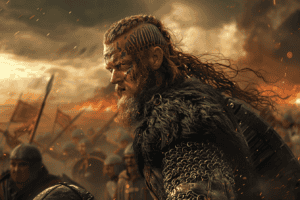The Vikings are known for their reputation as fierce warriors who raided and pillaged their way through Europe. But did they use human sacrifice to gain military success? This question has long been debated among historians and scholars, and the answer is not clear-cut.
While there is evidence to suggest that the Vikings did engage in human sacrifice, it is unclear whether they did so specifically for military success.
The Vikings believed in a pantheon of gods and goddesses, and they made offerings and sacrifices to these deities in order to gain their favor and protection. However, the exact nature of these sacrifices is not well understood.
Some historians argue that the Vikings may have believed that sacrificing a person, whether an enemy captive or a member of their own community, would give them an advantage in battle. Others suggest that the Vikings may have used human sacrifice as a way to intimidate their enemies and demonstrate their power and prowess.
Whatever the reason, the role of sacrifice in Viking warfare remains a topic of debate and speculation.
Historical Context of Viking Sacrificial Practices

Viking Beliefs and the Pantheon
The Vikings had a complex religious system that included many gods and goddesses. The most important of these were Odin, Thor, Frey, and Freyja. These gods were believed to have power over different aspects of life, including war, fertility, and death.
The Vikings believed that by making sacrifices to these gods, they could gain their favor and protection.
One of the most important gods in the Viking pantheon was Odin. He was the god of war and death, and was believed to lead the warriors who died in battle to Valhalla, the Viking afterlife. The Vikings believed that by sacrificing animals or even humans to Odin, they could ensure his favor in battle.
Rituals and Ceremonies in the Viking Age
The Vikings had many different rituals and ceremonies that were performed throughout the year. One of the most important of these was the blót, which was a sacrifice to the gods.
The blót was usually performed at the beginning of winter, and involved the sacrifice of animals such as cattle, horses, and pigs.
In addition to the blót, the Vikings also had other rituals and ceremonies that were performed during the year. These included feasts, weddings, and funerals. The Vikings believed that by performing these rituals and ceremonies, they could ensure the favor of the gods and gain their protection.
The Viking sagas and other historical accounts provide some evidence of human sacrifice in Viking society. For example, Adam of Bremen, a medieval chronicler, wrote that the Vikings sacrificed humans to Odin during battles. Snorri Sturluson, an Icelandic historian, also wrote about human sacrifice in his sagas.
While human sacrifice was not a common practice, it did occur in some cases, particularly in times of war. The Vikings believed that by making sacrifices to the gods, they could ensure their protection and gain an advantage in battle.
The Role of Sacrifice in Viking Warfare

Sacrifice for Victory in Battle
The Vikings believed that their gods controlled the world around them, and they viewed sacrifices as a way to gain their favor. Therefore, it is not surprising that they also performed sacrifices before going to battle. They believed that the gods would protect them and give them victory in battle if they offered the right sacrifices.
The Vikings offered various sacrifices before battle, including animals and sometimes even humans. They believed that the more significant the sacrifice, the more favor they would gain from the gods.
Sacrifices were often performed by the chieftains or leaders, who had the most to gain from victory in battle. The warriors would often participate in the sacrifices, as they believed that it would give them power and protection in battle.
Sacrificial Offerings and Military Strategy
The Vikings also used sacrificial offerings as part of their military strategy. They believed that the gods could be manipulated to give them victory in battle if they offered the right sacrifices.
For example, if they were fighting on the sea, they would offer sacrifices to the god of the sea, Njord. If they were fighting on land, they would offer sacrifices to the god of war, Odin.
The Vikings also believed that the location of the sacrifice was important. They would often perform the sacrifices at a sacred site or a place that was associated with the gods. This was believed to increase the power of the sacrifice and make it more effective.
Examining the Evidence of Human Sacrifice

Archaeological Discoveries and Interpretations
Archaeological finds have provided some evidence to support the idea that the Vikings may have used human sacrifice for military success.
For instance, skeletons of young children, aged between 4 and 7, were found in wells at sites such as Tissø and Lejre in Denmark. The Vikings attached great symbolic importance to wells, and Odin, one of their gods, gained wisdom by drinking from Mímir’s well, in exchange for sacrificing one of his eyes to Mímir. The discovery of these skeletons suggests that the Vikings may have used human sacrifice to appease their gods and gain military success.
Similarly, at the Uppsala temple in Sweden, excavations have revealed the remains of animals, including horses, and human bones that suggest ritual sacrifice. The temple was destroyed in the late 11th century, and the bones were found in the ashes. The discovery of these bones suggests that the Vikings may have used human sacrifice to gain military success.
Written Accounts and Their Validity
Written sources also suggest that the Vikings may have used human sacrifice for military success.
For example, Ahmad ibn Fadlan, an Arab traveler, wrote about the Vikings’ use of human sacrifice in his account of his journey to the Volga River in the 10th century. He witnessed the sacrifice of a slave girl, which he described in detail. However, it should be noted that the validity of these texts is contested because the writers were biased against the Viking religion.
Furthermore, there are two major accounts, both from Christian monks, which claim to show that the Vikings did indeed practice human sacrifice. However, these Christian scholars obviously had a political and religious agenda to try and portray the pagan Vikings in the worst possible light.
Cultural and Religious Interactions

Christianity’s Influence on Viking Practices
The Vikings were a pagan people who believed in a pantheon of gods and goddesses. However, the spread of Christianity throughout Europe had an impact on Viking practices, including their religious beliefs and cultural practices.
The conversion of the Vikings to Christianity began in the 10th century, and it was a gradual process that took several hundred years.
Christianity’s influence on Viking practices was significant. The Christian religion was spread through the use of Christian propaganda and the establishment of churches. This led to the gradual transition from paganism to Christianity, which had a profound impact on Viking culture.
One of the most significant changes brought about by the spread of Christianity was the abandonment of human sacrifice.
The Vikings believed that human sacrifice was necessary to appease their gods and gain favor in battle. However, as they converted to Christianity, they began to abandon this practice. The Christian religion taught that human sacrifice was a sin, and the Vikings began to adopt this belief.
Transition from Paganism to Christianity
The transition from paganism to Christianity was a gradual process that took several hundred years.
During this time, the Vikings began to adopt Christian practices and beliefs, while still maintaining some of their pagan traditions. This led to a blending of the two religions, which had a significant impact on Viking culture.
One of the most significant changes brought about by the transition from paganism to Christianity was the abandonment of human sacrifice.
The Vikings believed that human sacrifice was necessary to appease their gods and gain favor in battle. However, as they converted to Christianity, they began to abandon this practice.
The Christian religion taught that human sacrifice was a sin, and the Vikings began to adopt this belief.
Overall, the spread of Christianity had a significant impact on Viking practices, including their religious beliefs and cultural practices.










Add Comment